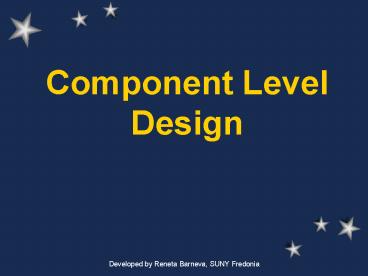Component Level Design - PowerPoint PPT Presentation
1 / 16
Title:
Component Level Design
Description:
... are responsible for supporting the processing required in the application ... Principle (OCP) - class should be open for extension but closed for modification ... – PowerPoint PPT presentation
Number of Views:207
Avg rating:3.0/5.0
Title: Component Level Design
1
Component Level Design
2
What is a Component?
- Has 3 Characteristics
- - Modular - A portion of a program that
performs a specific function. Can be combined
with other modules of the same program. - - Deployable
- - Replaceable Can be replaced by other
similar modules - In Object Oriented view of a Component is that
it is a set of collaborating classes
3
Why do we care about Components Level Design?
- Positives
- To define data structures, algorithms, interface
characteristics, and communication mechanisms for
each software component. - Represents the software in a way that allows the
designer to review it for correctness and
consistency, before it is built. - The CLD each software component is represented
using graphical, tabular, or text-based notation.
4
The Three Types Of Components
- Control components - coordinates all of the
other components - Problem domain components - implement a
function required by the customer - Infrastructure components - are responsible for
supporting the processing required in the
application
5
Object Oriented Component Design
- Focuses on the elaboration of Domain specific
classes and the definition of Infrastructure
classes - A detailed description of class attributes,
operations, and interfaces is required prior to
beginning the design
6
Principles For Designing Class-based Components
- Open-Closed Principle (OCP) - class should be
open for extension but closed for modification - Liskov Substitution Principle (LSP) - subclasses
should be substitutable for their base classes - Dependency Inversion Principle (DIP) - depend on
abstractions, do not depend on concretions - Interface Segregation Principle (ISP) - many
client specific interfaces are better than one
general purpose interface
7
Principles For Designing Class-based Components
- Release Reuse Equivalency Principle (REP) - the
granule of reuse is the granule of release - Common Closure Principle (CCP) - classes that
change together belong together - Common Reuse Principle (CRP) - classes that
can't be used together should not be grouped
together
8
UML Unified Markup Language
- The Unified Modeling Language (UML) is a
standard language for specifying, visualizing,
constructing, and documenting the artifacts of
software systems
9
Goals of UML
- Provide users with a expressive visual modeling
language so they can develop and exchange
meaningful models. - Provide extensibility and specialization
mechanisms to extend the core concepts. - Be independent of particular programming
languages and development processes. - Provide a formal basis for understanding the
modeling language. - Encourage the growth of the OO tools market.
- Support higher-level development concepts such as
collaborations, frameworks, patterns and
components.
10
UML Class Diagram
- Association relationship
- Inheritance
11
Cohesion
- Utility cohesion - components grouped within the
same category but are otherwise unrelated - Temporal cohesion - operations are performed to
reflect a specific behavior or state - Procedural cohesion - components grouped to
allow one be invoked immediately after the
preceding one was invoked with or without
passing data - Communicational cohesion - operations required
same data are grouped in same class
12
Cohesion
- Sequential cohesion - components grouped to
allow input to be passed from first to second
and so on - Layer cohesion - exhibited by package components
when a higher level layer accesses the services
of a lower layer, but lower level layers do not
access higher level layer services - Functional cohesion - module performs one and
only one function
13
Coupling
- Data coupling - occurs when long strings of
arguments are passed between components - Stamp coupling - occurs when parts of larger
data structures are passed between components - Control coupling - occurs when one component
passes control flags as arguments to another - External coupling - occurs when a component
communicates or collaborates with in
infrastructure component (e.g., database)
14
Coupling
- Common coupling - occurs when several components
make use of a global variable - Content coupling - occurs when one component
surreptitiously modifies internal data in
another component - Routine call coupling - occurs when one operator
invokes another - Type use coupling - occurs when one component
uses a data type defined in another - Inclusion or import coupling - occurs when one
component imports a package or uses the content
of another
15
Steps For Conducting Component Level Design
- Identify all design classes that correspond to
the problem domain. - Identify all design classes that correspond to
the infrastructure domain. - Elaborate all design classes that are not
acquired as reusable components. - Specify message details when classes or
components collaborate. - Identify appropriate interfaces for each
component. - Elaborate attributes and define data types and
data structures required to implement them. - Describe processing flow within each operation in
detail.
16
Steps For Conducting Component Level Design
- 4. Identify persistent data sources (databases
and files) and identify the classes required to
manage them. - 5. Develop and elaborate behavioral
representations for each class or component. - 6. Elaborate deployment diagrams to provide
additional implementation detail. - 7. Factor every component-level diagram
representation and consider alternatives.































